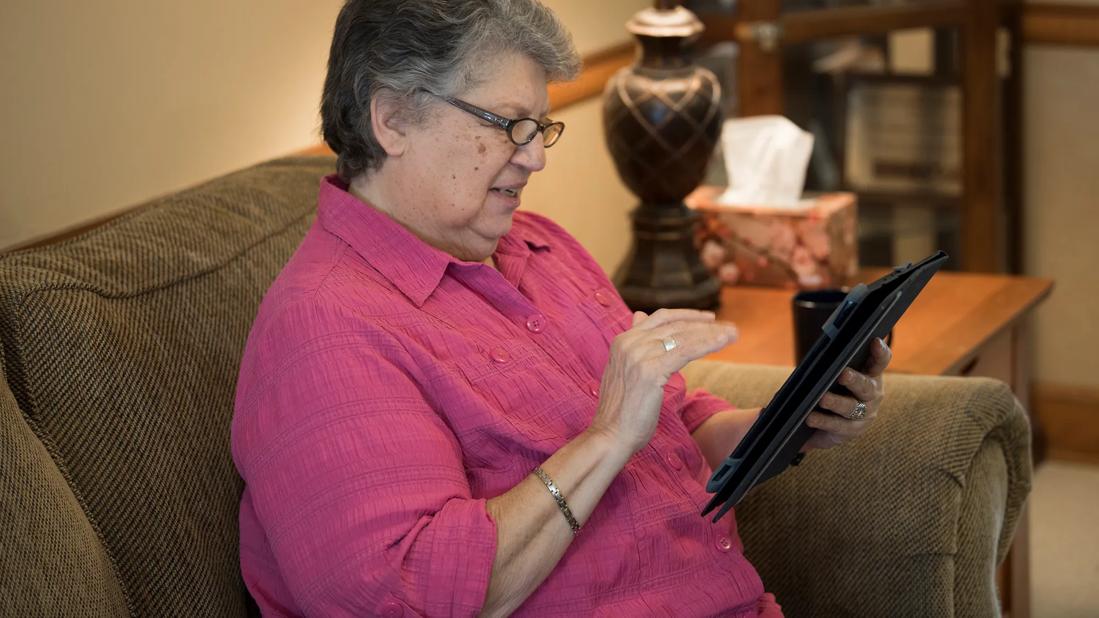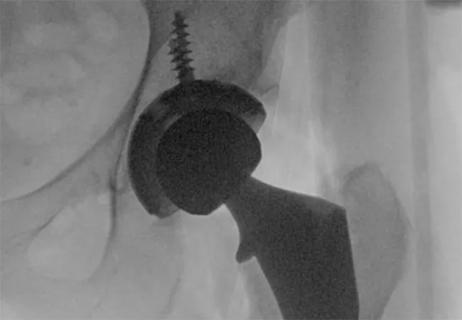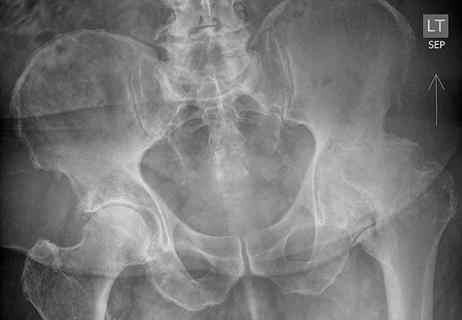Insights to help orthopaedic practices comply with the 2025 CMS mandate

In 2025, the Centers for Medicare & Medicaid Services (CMS) will begin requiring the collection and reporting of patient-reported outcome measures (PROMs) for hospital inpatients having total hip or knee arthroplasty in the U.S. The change is part of an overall shift towards value-based medicine.
Advertisement
Cleveland Clinic is a non-profit academic medical center. Advertising on our site helps support our mission. We do not endorse non-Cleveland Clinic products or services. Policy
“We are committed to this value proposition, and we believe in it, which is why we have been collecting PROMs from Cleveland Clinic orthopaedic patients for more than 10 years,” says Nicolas S. Piuzzi, MD, Enterprise Vice Chair of Research for Orthopaedics and Rehabilitation at Cleveland Clinic.
Patients opt for joint replacement because of pain or poor function, he notes. So, to properly assess results of total knee arthroplasty (TKA) or total hip arthroplasty (THA), the patient’s perception of their pain and function should be measured and reported. At Cleveland Clinic, patients are asked to complete Knee Injury and Osteoarthritis Outcome Score (KOOS) and Hip Disability and Osteoarthritis Outcome Score (HOOS) questionnaires before surgery and one year after surgery.
“We ask them to assess their improvement in pain and function and their overall satisfaction, so we are truly measuring patient-perceived value of their joint care,” Dr. Piuzzi says.
While tracking PROMs is good from a value perspective, there are logistical challenges. Data collection and reporting increases workload for clinical and administrative teams. And some patients do not respond to surveys despite numerous requests.
This could be cause for concern in light of CMS’s mandate to report PROMs from at least 50% of a medical center’s elective TKA and THA patients. PROMs reporting will affect CMS reimbursement for hip and knee arthroplasty beginning in 2028.
Over the past decade, the Cleveland Clinic Adult Reconstruction Research (CCARR) team has published its findings on PROMs reporting, including its feasibility and challenges. They will share more insights at the 2025 American Academy of Orthopaedic Surgeons (AAOS) meeting, including the two studies highlighted below.
Advertisement
In one podium presentation, CCARR fellow Ignacio Pasqualini, MD, will discuss the need for active versus passive methods of follow-up reminding patients to complete PROMs questionnaires one year after THA.
“Passive methods include automated email, text or patient portal messages inviting patients to complete HOOS surveys,” explains Dr. Pasqualini. “Active methods are more resource-intensive and used when passive methods are unsuccessful. They include personally calling patients and manually mailing HOOS surveys. Patients are considered ‘lost to follow-up’ when they do not respond to either active or passive methods, or they opt out of further contact.”
A prospective study of nearly 5,500 patients age 65 or older who had primary THA at Cleveland Clinic revealed that those having inpatient care had lower postoperative PROMs completion rates than those having outpatient care (75% vs. 85%).
A greater percentage of inpatients required active follow-up before reporting their outcomes (55% inpatient vs. 48% outpatient). Inpatients were slightly less likely than outpatients to report outcomes after passive follow-up (45% inpatient vs. 52% outpatient).

In another AAOS podium presentation, CCARR fellow Khaled A. Elmenawi, MD, will discuss differences in outcomes reporting in patients with Medicare versus other types of insurance.
A prospective study of more than 4,300 patients age 65 or older who had primary TKA at Cleveland Clinic revealed the following percentages of PROMs completed according to insurance type:
Advertisement
| Insurance type | Before TKA | 1 year after TKA |
|---|---|---|
| Commercial | 93% | 77% |
| Medicare | 88% | 77% |
| Workers’ compensation | 88% | 65% |
| Self-paid | 90% | 55% |
| Medicaid | 84% | 55% |
| Insurance type | ||
| Commercial | ||
| Before TKA | ||
| 93% | ||
| 1 year after TKA | ||
| 77% | ||
| Medicare | ||
| Before TKA | ||
| 88% | ||
| 1 year after TKA | ||
| 77% | ||
| Workers’ compensation | ||
| Before TKA | ||
| 88% | ||
| 1 year after TKA | ||
| 65% | ||
| Self-paid | ||
| Before TKA | ||
| 90% | ||
| 1 year after TKA | ||
| 55% | ||
| Medicaid | ||
| Before TKA | ||
| 84% | ||
| 1 year after TKA | ||
| 55% |
“PROMs capture rates were similar at baseline across groups but substantially different at one year,” Dr. Elmenawi says. “This finding underscores that the ability to capture PROMs largely varies across patients and will be a major challenge for institutions.”
The same cohort then was assessed for achieving substantial clinical benefit (SCB) according to KOOS-JR scores. Overall, non-Medicare patients were 1.3 times more likely not to achieve SCB (P = .02) compared to patients with Medicare.
| Insurance type | Odds ratio of failing to achieve SCB relative to Medicare patients |
|---|---|
| Workers’ compensation | 5.1 (P < .01) |
| Commercial | 1.5 (P = .03) |
| Medicaid | 1.3 (P < .01) |
| Self-paid | 1.2 (P = .70) |
| All non-Medicare | 1.3 (P = .02) |
| Insurance type | |
| Workers’ compensation | |
| Odds ratio of failing to achieve SCB relative to Medicare patients | |
| 5.1 (P < .01) | |
| Commercial | |
| Odds ratio of failing to achieve SCB relative to Medicare patients | |
| 1.5 (P = .03) | |
| Medicaid | |
| Odds ratio of failing to achieve SCB relative to Medicare patients | |
| 1.3 (P < .01) | |
| Self-paid | |
| Odds ratio of failing to achieve SCB relative to Medicare patients | |
| 1.2 (P = .70) | |
| All non-Medicare | |
| Odds ratio of failing to achieve SCB relative to Medicare patients | |
| 1.3 (P = .02) |
“These findings highlight distinct patient characteristics across different insurance groups,” Dr. Elmenawi says. “Healthcare policymakers may use this information when attempting broader implementation of the CMS Patient-Reported Outcome-Based Performance Measure program.”
These AAOS presentations raise awareness of the challenges that orthopaedic practices could face as they take steps to comply with the new CMS mandate. But Dr. Piuzzi has a bigger concern.
“What will we do with these patient-reported data? How will we incorporate PROMs into our care pathways?” he asks. “It’s important to hear from patients and get their input, but we need to be sure that we’re not just collecting the data. We need to look at how these data will ultimately return value to the patient and healthcare system.”
For example, patients who score lower before surgery often report worse outcomes after surgery, he says.
“Improving outcomes postop may require us to do better at optimizing health preop,” Dr. Piuzzi says. “Mitigating surgical risk factors like obesity, diabetes and poor mental health or better addressing mobility factors are important to ensuring the best personalized outcomes.”
Advertisement
Advertisement
Advertisement

Multidisciplinary care can make arthroplasty a safe option even for patients with low ejection fraction

High-risk procedure prepares patient for lifesaving heart surgery

Cleveland Clinic is among the first in the U.S. to perform the procedure

Dr. Piuzzi wins 2025 Kappa Delta Young Investigator Award for pioneering work

For patients with anatomic abnormalities, substantial bone loss and pre-existing hardware

How it actually compares to posterior and lateral approaches

Offers adequate exposure of normal and abnormal anatomy

Custom components offer better outcomes when conventional options fail